Combination of Natural Deep Eutectic Solvents and Nano-Liquid Chromatography towards White Analytical Chemistry: A Practical Application
Abstract
:1. Introduction
2. Materials and Methods
2.1. Chemicals and Materials
2.2. Sample Selection
2.3. Apparatus and Software
2.4. Preparation of Packed Capillaries
2.5. NADES Preparation
2.6. Microextraction Tests
2.7. Sustainability Assessment Tools
3. Results and Discussion
3.1. Optimization of the Nano-LC-UV Method
3.2. NADES-LLME-Nano-LC-UV Method for the Analysis of Vegetable Oil Samples
3.3. Sustainability Assessment
4. Conclusions
Author Contributions
Funding
Data Availability Statement
Acknowledgments
Conflicts of Interest
References
- United Nations A/RES/70/1. Resolution Adopted by the General Assembly on 25 September 2015. Transforming Our World: The 2030 Agenda for Sustainable Development. General Assembly of the United Nations 2015. Available online: https://undocs.org/en/A/RES/70/1 (accessed on 11 April 2024).
- Nowak, P.M.; Wietecha-Posłuszny, R.; Pawliszyn, J. White Analytical Chemistry: An Approach to Reconcile the Principles of Green Analytical Chemistry and Functionality. TrAC—Trends Anal. Chem. 2021, 138, 116223. [Google Scholar] [CrossRef]
- Ballesteros-Vivas, D.; Socas-Rodríguez, B.; Mendiola, J.A.; Ibáñez, E.; Cifuentes, A. Green Food Analysis: Current Trends and Perspectives. Curr. Opin. Green Sustain. Chem. 2021, 31, 100522. [Google Scholar] [CrossRef]
- Koel, M. Do We Need Green Analytical Chemistry? Green Chem. 2016, 18, 923–931. [Google Scholar] [CrossRef]
- Anastas, P.T.; Warner, J.C. Green Chemistry: Theory and Practice; Online; Oxford University Press: Oxford, UK, 2000; ISBN 9780197704059. [Google Scholar]
- Fanali, S.; D’Orazio, G.; Quaglia, M.G. Separation of Aryl Propionic Acids by Capillary Liquid Chromatography. Chromatographia 2004, 60, S239–S243. [Google Scholar] [CrossRef]
- Liu, W.; Zhang, K.; Chen, J.; Yu, J. Ascorbic Acid and Choline Chloride: A New Natural Deep Eutectic Solvent for Extracting Tert-Butylhydroquinone Antioxidant. J. Mol. Liq. 2018, 260, 173–179. [Google Scholar] [CrossRef]
- Asensio-ramos, M.; Fanali, C.; D’Orazio, G.; Fanali, S. Nano-Liquid Chromatography. In Liquid Chromatography: Fundamentals and Instrumentation; Fanali, S., Haddad, P.R., Poole, C.F., Riekkola, M.-L., Eds.; Elsevier: Amsterdam, The Netherlands, 2017; pp. 637–695. ISBN 9780128053935. [Google Scholar]
- dos Santos, N.G.P.; Maciel, E.V.S.; Medina, D.A.V.; Lanças, F.M. NanoLC-EI-MS: Perspectives in Biochemical Analysis. Int. J. Mol. Sci. 2023, 24, 11746. [Google Scholar] [CrossRef]
- Cestaro, B.I.; Machado, K.C.; Batista, M.; da Silva, B.J.G. Hollow-Fiber Liquid Phase Microextraction for Determination of Fluoxetine in Human Serum by Nano-Liquid Chromatography Coupled to High Resolution Mass Spectrometry. J. Chromatogr. B 2024, 1234, 124018. [Google Scholar] [CrossRef]
- Perna, F.M.; Vitale, P.; Capriati, V. Deep Eutectic Solvents and Their Applications as Green Solvents. Curr. Opin. Green Sustain. Chem. 2020, 21, 27–33. [Google Scholar] [CrossRef]
- Prabhune, A.; Dey, R. Green and Sustainable Solvents of the Future: Deep Eutectic Solvents. J. Mol. Liq. 2023, 379, 121676. [Google Scholar] [CrossRef]
- Álvarez, M.S.; Longo, M.A.; Rodríguez, A.; Deive, F.J. The Role of Deep Eutectic Solvents in Catalysis. A Vision on Their Contribution to Homogeneous, Heterogeneous and Electrocatalytic Processes. J. Ind. Eng. Chem. 2024, 132, 36–49. [Google Scholar] [CrossRef]
- Al-Farsi, R.; Hayyan, M. Paving the Way for Advancement of Renewable Energy Technologies Using Deep Eutectic Solvents: A Review. Renew. Sustain. Energy Rev. 2023, 184, 113505. [Google Scholar] [CrossRef]
- Jafari, K.; Fatemi, M.H.; Estellé, P. Deep Eutectic Solvents (DESs): A Short Overview of the Thermophysical Properties and Current Use as Base Fluid for Heat Transfer Nanofluids. J. Mol. Liq. 2021, 321, 114752. [Google Scholar] [CrossRef]
- Ge, X.; Gu, C.; Wang, X.; Tu, J. Deep Eutectic Solvents (DESs)-Derived Advanced Functional Materials for Energy and Environmental Applications: Challenges, Opportunities, and Future Vision. J. Mater. Chem. A 2017, 5, 8209–8229. [Google Scholar] [CrossRef]
- Mannucci, G.; Teixeira, G.; Sosa, F.H.B.; Palluzzi, M.; Busato, M.; Coutinho, J.A.P.; D’Angelo, P. Predicting the Thermal Behavior in the Design of Type V Deep Eutectic Solvents: The Combined Role of Polarity and Steric Asymmetry. ACS Sustain. Chem. Eng. 2024, 12, 2862–2870. [Google Scholar] [CrossRef]
- Santana-Mayor, Á.; Rodríguez-ramos, R.; Herrera-herrera, A.V.; Socas-Rodríguez, B.; Rodríguez-Delgado, M.Á. Trends in Analytical Chemistry Deep Eutectic Solvents. The New Generation of Green Solvents in Analytical Chemistry Alvaro. TrAC—Trends Anal. Chem. 2021, 134, 116108. [Google Scholar] [CrossRef]
- Cunha, S.C.; Lapa, R.; Fernandes, O. Trends in Analytical Chemistry Deep Eutectic Solvents for Microextraction of Endocrine Disruptor Contaminants from Water and Food: Review. TrAC—Trends Anal. Chem. 2024, 171, 117495. [Google Scholar] [CrossRef]
- Mansour, F.R.; Bedair, A.; Hamed, M.; Magdy, G.; Ali, I.; Locatelli, M. Applications of (Natural) Deep Eutectic Solvents in Liquid Phase Microextraction: A Review. Microchem. J. 2024, 198, 110178. [Google Scholar] [CrossRef]
- Molnar, M.; Gašo-Sokač, D.; Komar, M.; Jakovljević Kovač, M.; Bušić, V. Potential of Deep Eutectic Solvents in the Extraction of Organic Compounds from Food Industry By-Products and Agro-Industrial Waste. Separations 2024, 11, 35. [Google Scholar] [CrossRef]
- Fanali, S.; Aturki, Z.; D’Orazio, G.; Rocco, A.; Ferranti, A.; Mercolini, L.; Raggi, M.A. Analysis of Aloe-Based Phytotherapeutic Products by Using Nano-LC-MS. J. Sep. Sci. 2010, 33, 2663–2670. [Google Scholar] [CrossRef] [PubMed]
- Khezeli, T.; Daneshfar, A.; Sahraei, R. A Green Ultrasonic-Assisted Liquid-Liquid Microextraction Based on Deep Eutectic Solvent for the HPLC-UV Determination of Ferulic, Caffeic and Cinnamic Acid from Olive, Almond, Sesame and Cinnamon Oil. Talanta 2016, 150, 577–585. [Google Scholar] [CrossRef]
- Sang, J.; Li, B.; Huang, Y.Y.; Ma, Q.; Liu, K.; Li, C.Q. Deep Eutectic Solvent-Based Extraction Coupled with Green Two-Dimensional HPLC-DAD-ESI-MS/MS for the Determination of Anthocyanins from Lycium ruthenicum Murr. Fruit. Anal. Methods 2018, 10, 1247–1257. [Google Scholar] [CrossRef]
- Huang, Y.; Feng, F.; Jiang, J.; Qiao, Y.; Wu, T.; Voglmeir, J.; Chen, Z.G. Green and Efficient Extraction of Rutin from Tartary Buckwheat Hull by Using Natural Deep Eutectic Solvents. Food Chem. 2017, 221, 1400–1405. [Google Scholar] [CrossRef]
- Gałuszka, A.; Migaszewski, Z.M.; Konieczka, P.; Namieśnik, J. Analytical Eco-Scale for Assessing the Greenness of Analytical Procedures. TrAC—Trends Anal. Chem. 2012, 37, 61–72. [Google Scholar] [CrossRef]
- Pena-Pereira, F.; Wojnowski, W.; Tobiszewski, M. AGREE—Analytical GREEnness Metric Approach and Software. Anal. Chem. 2020, 92, 10076–10082. [Google Scholar] [CrossRef]
- Manousi, N.; Wojnowski, W.; Płotka-Wasylka, J.; Samanidou, V. Blue Applicability Grade Index (BAGI) and Software: A New Tool for the Evaluation of Method Practicality. Green Chem. 2023, 25, 7598–7604. [Google Scholar] [CrossRef]
- National Library of Medicine (US). National Center for Biotechnology Information PubChem. Available online: https://pubchem.ncbi.nlm.nih.gov/ (accessed on 8 March 2024).
- Kennedy, R.T.; Jorgenson, J.W. Preparation and Evaluation of Packed Capillary Liquid Chromatography Columns with Inner Diameters from 20 to 50 Μm. Anal. Chem. 1989, 61, 1128–1135. [Google Scholar] [CrossRef]
- Vissers, J.P.C. Recent Developments in Microcolumn Liquid Chromatography. J. Chromatogr. A 1999, 856, 117–143. [Google Scholar] [CrossRef]
- Vissers, J.P.C.; De Ru, A.H.; Ursem, M.; Chervet, J.P. Optimised Injection Techniques for Micro and Capillary Liquid Chromatography. J. Chromatogr. A 1996, 746, 1–7. [Google Scholar] [CrossRef]
- Héron, S.; Tchapla, A.; Chervet, J.P. Influence of Injection Parameters on Column Performance in Nanoscale High-Performance Liquid Chromatography. Chromatographia 2000, 51, 495–499. [Google Scholar] [CrossRef]
- Rodríguez-Ramos, R.; Herrera-Herrera, A.V.; Díaz-Romero, C.; Socas-Rodríguez, B.; Rodríguez-Delgado, M.Á. Eco-Friendly Approach Developed for the Microextraction of Xenobiotic Contaminants from Tropical Beverages Using a Camphor-Based Natural Hydrophobic Deep Eutectic Solvent. Talanta 2024, 266, 124932. [Google Scholar] [CrossRef]
- Baute-Pérez, D.; Santana-Mayor, Á.; Herrera-Herrera, A.V.; Socas-Rodríguez, B.; Rodríguez-Delgado, M.Á. Analysis of Alkylphenols, Bisphenols and Alkylphenol Ethoxylates in Microbial-Fermented Functional Beverages and Bottled Water: Optimization of a Dispersive Liquid-Liquid Microextraction Protocol Based on Natural Hydrophobic Deep Eutectic Solvents. Food Chem. 2022, 377, 131921. [Google Scholar] [CrossRef]
- Wang, Y.; Li, J.; Sun, D.; Yang, S.; Liu, H.; Chen, L. Strategies of Dispersive Liquid-Liquid Microextraction for Coastal Zone Environmental Pollutant Determination. J. Chromatogr. A 2021, 1658, 462615. [Google Scholar] [CrossRef]
- Santana-Mayor, Á.; Socas-Rodríguez, B.; Rodríguez-Ramos, R.; Rodríguez-Delgado, M.Á. A Green and Simple Procedure Based on Deep Eutectic Solvents for the Extraction of Phthalates from Beverages. Food Chem. 2020, 312, 125798. [Google Scholar] [CrossRef]
- Santana-Mayor, Á.; Rodríguez-Ramos, R.; Socas-Rodríguez, B.; Rodríguez-Delgado, M.Á.; D’Orazio, G. Nano-Liquid Chromatography Combined with a Sustainable Microextraction Based on Natural Deep Eutectic Solvents for Analysis of Phthalate Esters. Electrophoresis 2020, 41, 1768–1775. [Google Scholar] [CrossRef]
- Rodríguez-Juan, E.; Rodríguez-Romero, C.; Fernández-Bolaños, J.; Florido, M.C.; Garcia-Borrego, A. Phenolic Compounds from Virgin Olive Oil Obtained by Natural Deep Eutectic Solvent (NADES): Effect of the Extraction and Recovery Conditions. J. Food Sci. Technol. 2021, 58, 552–561. [Google Scholar] [CrossRef]
- Jing, X.; Cao, C.; Wu, W.; Zhao, W.; Wang, Y. Deep Eutectic Solvent-Based Vortex-Assisted Dispersive Liquid–Liquid Microextraction Combined with High Performance Liquid Chromatography for the Determination of Phenolic Acids in Vegetable Oils. Food Sci. Technol. Res. 2019, 25, 563–568. [Google Scholar] [CrossRef]
- Coscarella, M.; Nardi, M.; Alipieva, K.; Bonacci, S.; Popova, M.; Procopio, A.; Scarpelli, R.; Simeonov, S. Alternative Assisted Extraction Methods of Phenolic Compounds Using NaDESs. Antioxidants 2024, 13, 62. [Google Scholar] [CrossRef]
- National Water Quality Monitoring Council; U.S. Geological Survey (USGS); (USEPA), U.S.E.P.A. NEMI—National Environamental Methods Index. Available online: https://www.nemi.gov/home/ (accessed on 8 March 2024).
- Płotka-Wasylka, J. A New Tool for the Evaluation of the Analytical Procedure: Green Analytical Procedure Index. Talanta 2018, 181, 204–209. [Google Scholar] [CrossRef]
- Płotka-Wasylka, J.; Wojnowski, W. Complementary Green Analytical Procedure Index (ComplexGAPI) and Software. Green Chem. 2021, 23, 8657–8665. [Google Scholar] [CrossRef]
- Wojnowski, W.; Tobiszewski, M.; Pena-pereira, F.; Psillakis, E. AGREEprep—Analytical Greenness Metric for Sample Preparation. TrAC—Trends Anal. Chem. Anal. Chem. 2022, 149, 116553. [Google Scholar] [CrossRef]
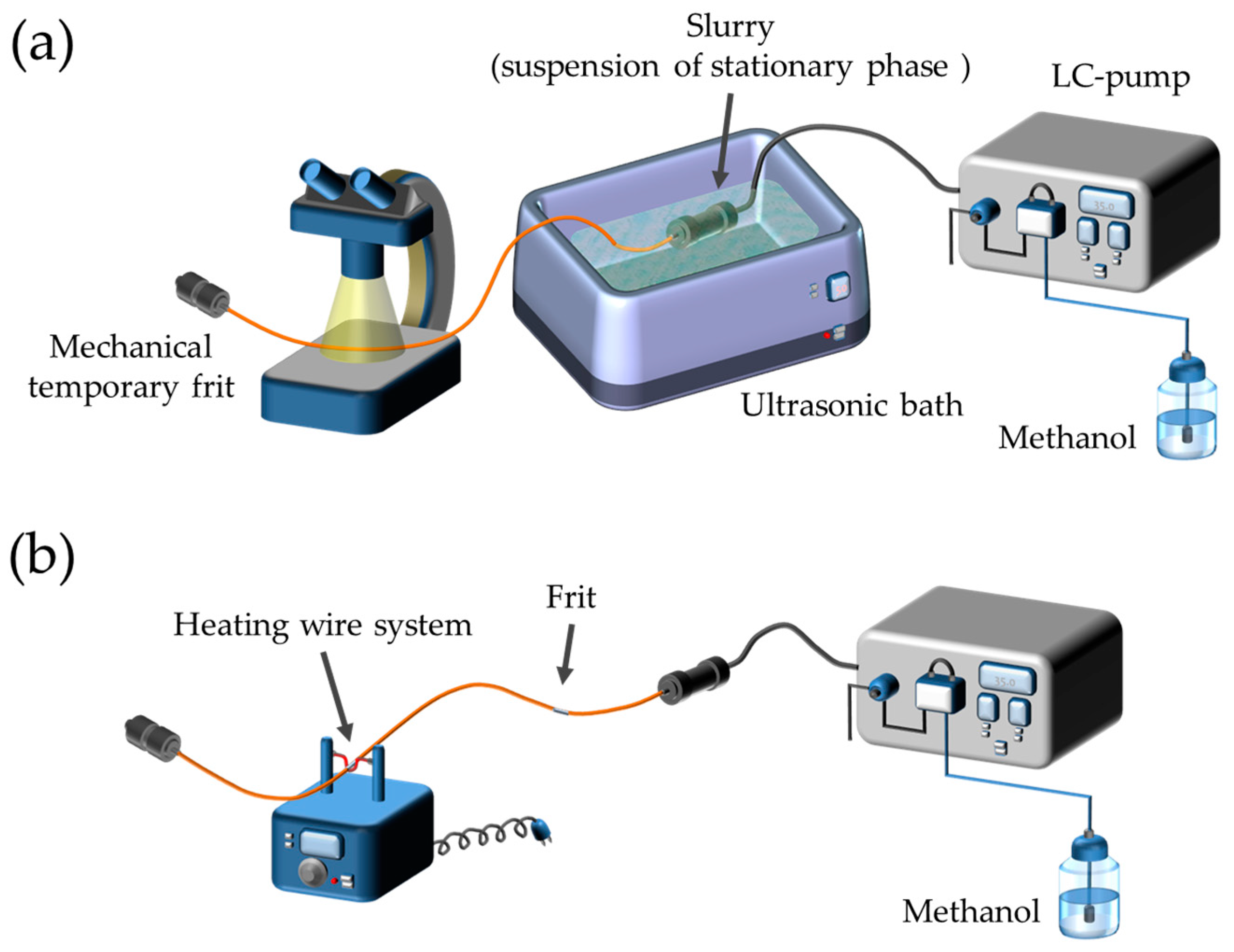
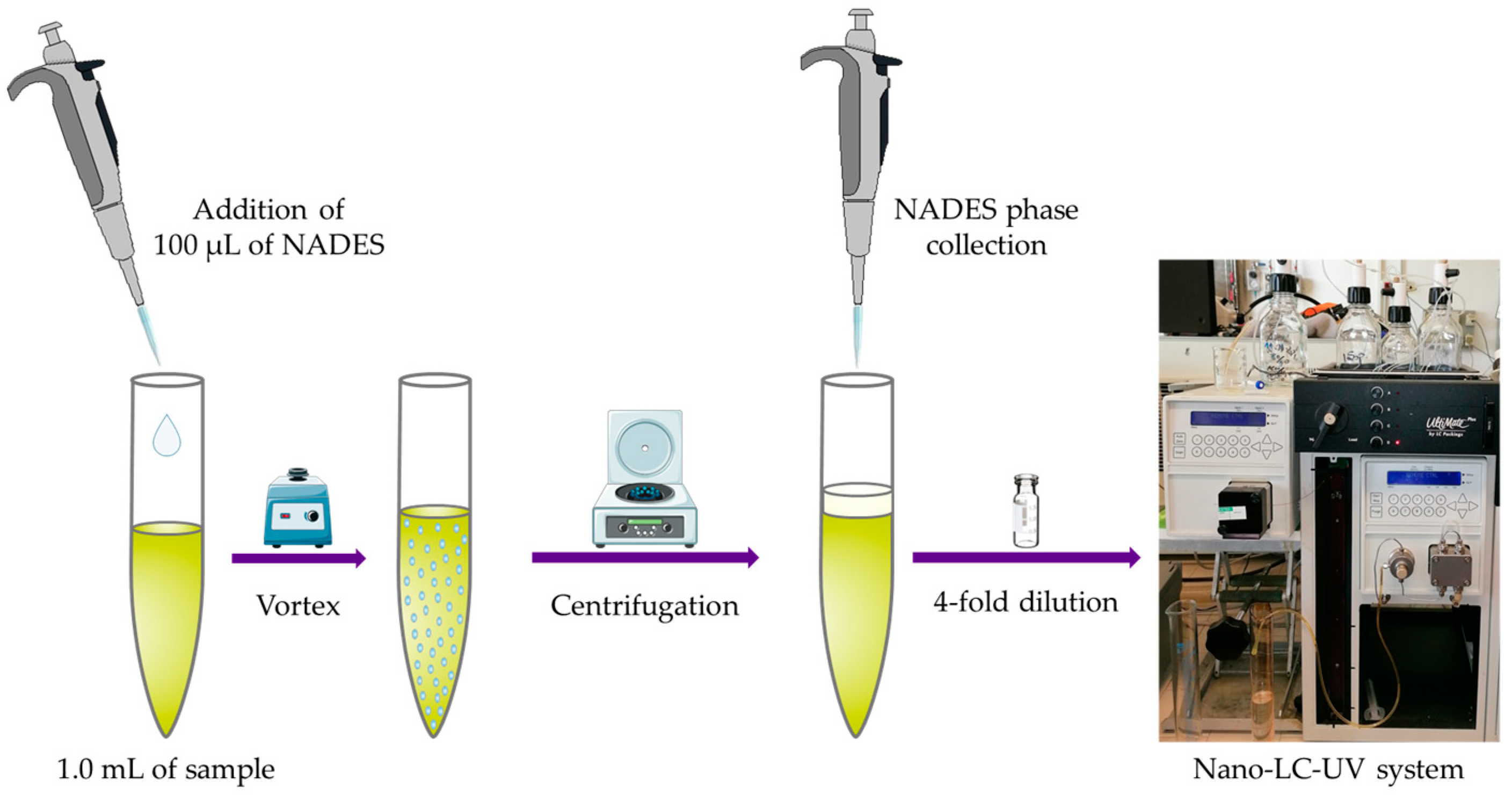
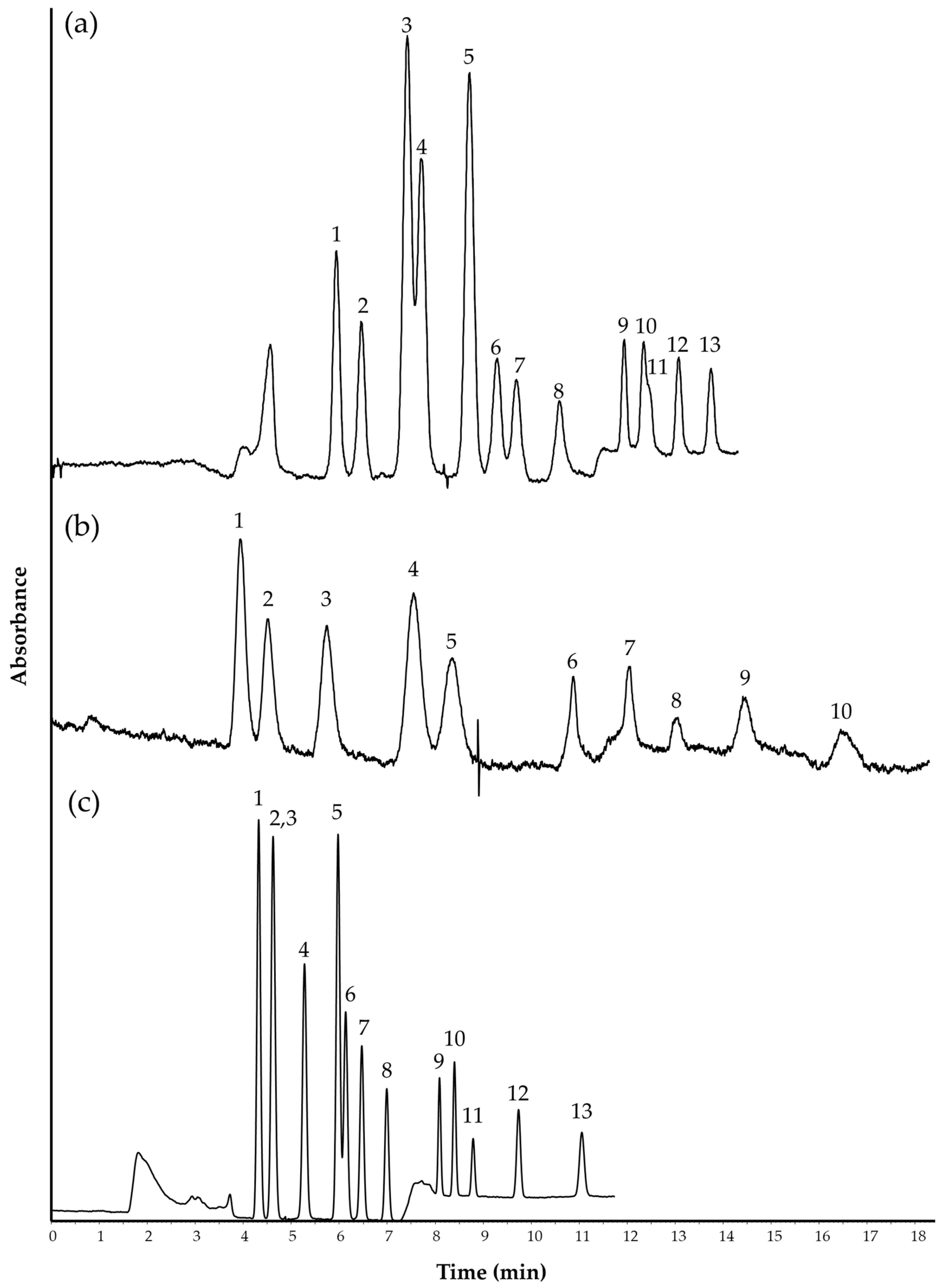
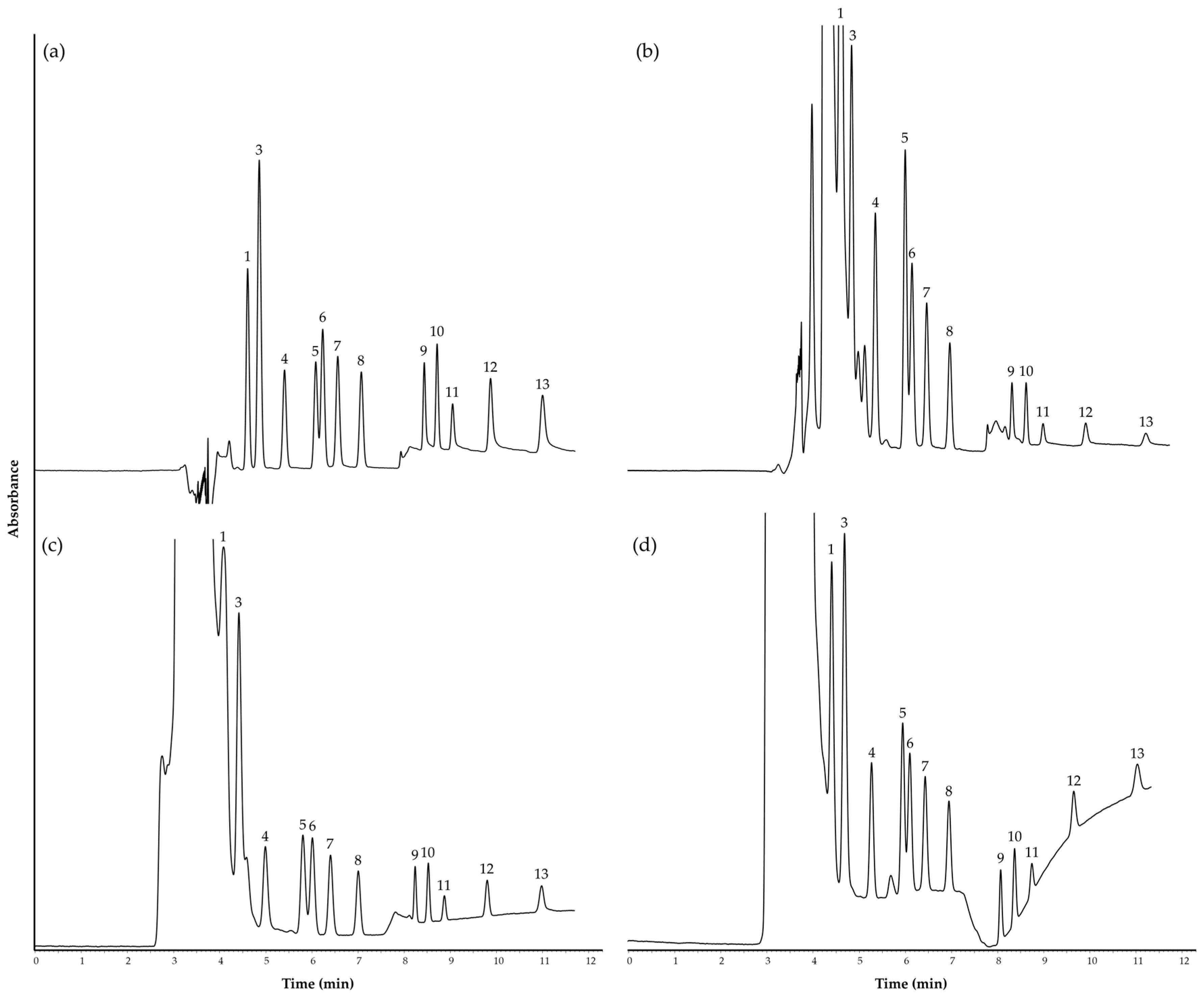
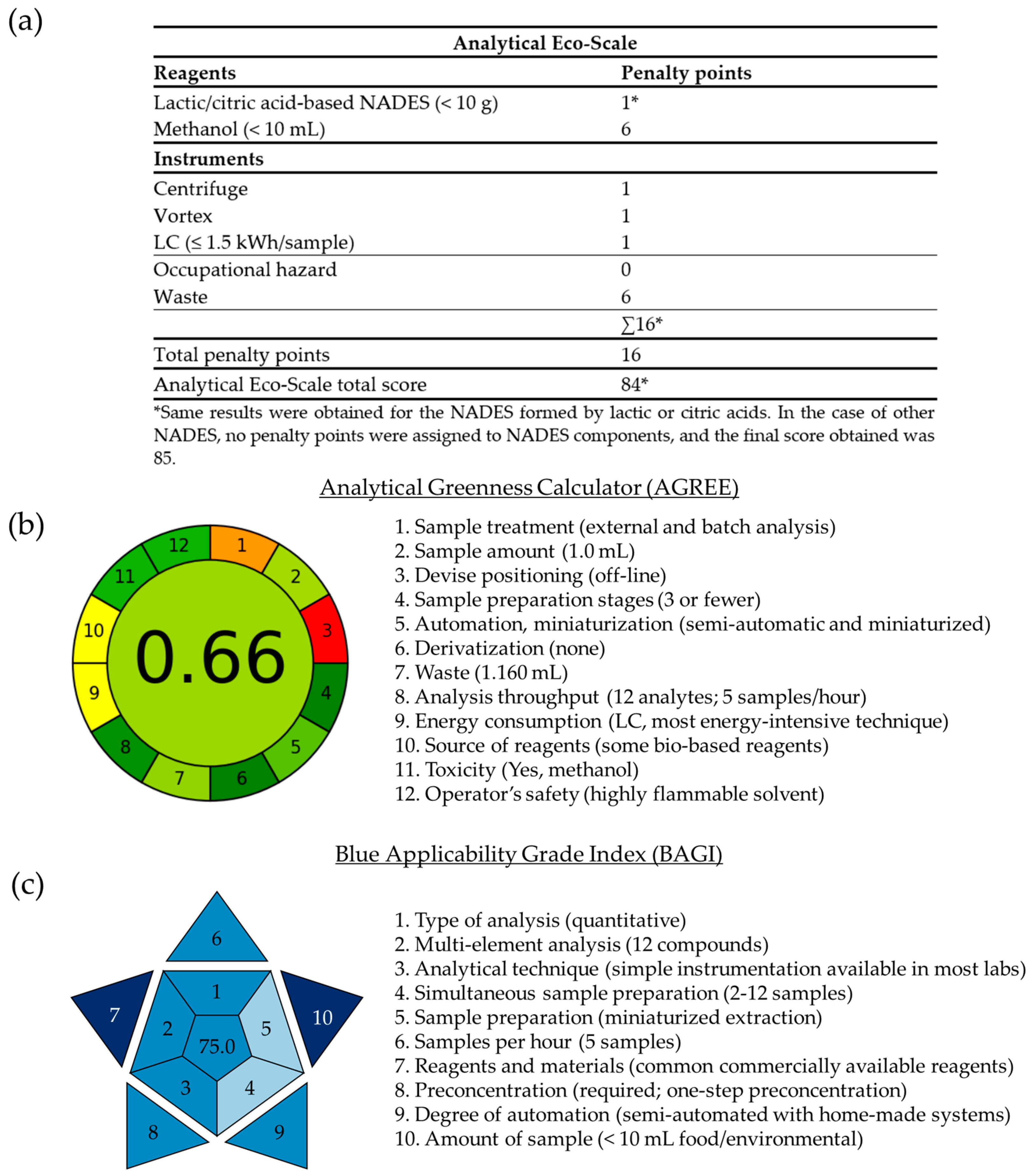
| Stationary Phase | Column Conditioning | Step gradient (Time; Composition) |
|---|---|---|
| Pinnacle II phenyl | 50/50, ACN/H2O, v/v | 8.1 min; 70/30, ACN/H2O, v/v |
| Cogent Bidentate C18™ | 50/50, ACN/H2O, v/v | 9.0 min; 80/20, ACN/H2O, v/v |
| XBridge® C18 | 70/30, ACN/H2O, v/v | 5.5 min; 90/10, ACN/H2O, v/v |
| Component 1 | Component 2 | Component 3 | Molar Ratio | Reference |
|---|---|---|---|---|
| Choline chloride | Glycerol | - | 1:2 | [23] |
| Choline chloride | Lactic acid | - | 1:2 | [24] |
| Choline chloride | Ascorbic acid | H2O | 2:1:4 | [7] |
| Choline chloride | Citric acid | H2O | 2:1:4 | [24] |
| Glycerol | l-Alanine | - | 3:1 | [25] |
| Glycerol | l-Histidine | - | 3:1 | [25] |
| Glycerol | l-Proline | - | 3:1 | [25] |
| Glycerol | l-Lysine | - | 4.5:1 | [25] |
Disclaimer/Publisher’s Note: The statements, opinions and data contained in all publications are solely those of the individual author(s) and contributor(s) and not of MDPI and/or the editor(s). MDPI and/or the editor(s) disclaim responsibility for any injury to people or property resulting from any ideas, methods, instructions or products referred to in the content. |
© 2024 by the authors. Licensee MDPI, Basel, Switzerland. This article is an open access article distributed under the terms and conditions of the Creative Commons Attribution (CC BY) license (https://creativecommons.org/licenses/by/4.0/).
Share and Cite
Santana-Mayor, Á.; D’Orazio, G.; Fanali, S.; Rodríguez-Delgado, M.Á.; Socas-Rodríguez, B. Combination of Natural Deep Eutectic Solvents and Nano-Liquid Chromatography towards White Analytical Chemistry: A Practical Application. Separations 2024, 11, 119. https://doi.org/10.3390/separations11040119
Santana-Mayor Á, D’Orazio G, Fanali S, Rodríguez-Delgado MÁ, Socas-Rodríguez B. Combination of Natural Deep Eutectic Solvents and Nano-Liquid Chromatography towards White Analytical Chemistry: A Practical Application. Separations. 2024; 11(4):119. https://doi.org/10.3390/separations11040119
Chicago/Turabian StyleSantana-Mayor, Álvaro, Giovanni D’Orazio, Salvatore Fanali, Miguel Ángel Rodríguez-Delgado, and Bárbara Socas-Rodríguez. 2024. "Combination of Natural Deep Eutectic Solvents and Nano-Liquid Chromatography towards White Analytical Chemistry: A Practical Application" Separations 11, no. 4: 119. https://doi.org/10.3390/separations11040119











